-
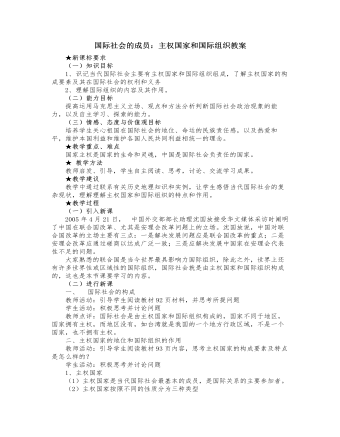
人教版高中政治必修2国际社会的成员:主权国家和国际组织教案
(1)1945.10.24日,《联合国宪章》生效,联合国正式成立。主要机构有:联合国大会、安全理事会、经济及社会理事会、托管理事会、国际法院、秘书处等。(2)联合国的宗旨:维护国际和平与安全;发展国际间以尊重人民平等权利及自决原则为基础的友好关系;促进国际合作,以解决国际间属于经济、社会、文化及人类福利性质的国际问题;作为协调各国活动的中心。简单地说,就是维护国际和平与安全,促进国际合作与发展。(3)联合国的原则:各会员国主权平等,履行宪章规定的义务,以和平方式解决国际争端,不得对其他国家进行武力威胁或使用武力,集体协作,不干涉任何国家的内政,确保非会员国遵守上述原则。(4)联合国的作用:联合国在维护世界和平与安全,促进经济、社会的发展,以及实行人道主义援助等方面发挥着积极作用。
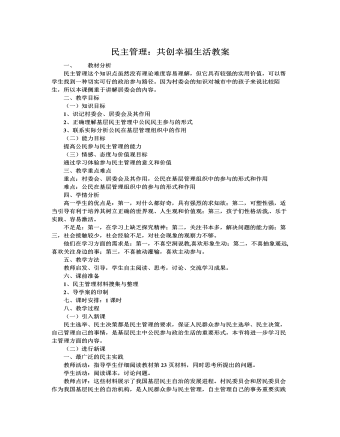
人教版高中政治必修2民主管理:共创幸福生活教案
一、 教材分析民主管理这个知识点虽然没有理论难度容易理解,但它具有较强的实用价值,可以帮学生找到一种切实可行的政治参与路径。因为村委会的知识对城市中的孩子来说比较陌生,所以本课侧重于讲解居委会的内容。二、教学目标(一)知识目标1、识记村委会、居委会及其作用2、正确理解基层民主管理中公民民主参与的形式3、联系实际分析公民在基层管理组织中的作用(二)能力目标提高公民参与民主管理的能力(三)情感、态度与价值观目标通过学习体验参与民主管理的意义和价值三、教学重点难点重点:村委会、居委会及其作用,公民在基层管理组织中的参与的形式和作用难点:公民在基层管理组织中的参与的形式和作用四、学情分析高一学生的优点是:第一,对什么都好奇,具有强烈的求知欲;第二,可塑性强,适当引导有利于培养其树立正确的世界观、人生观和价值观;第三,孩子们性格活泼,、乐于实践、容易激活。

人教版高中政治必修3永恒的中华民族精神教案
1.爱国主义是中华民族精神的核心爱国主义是中华民族精神的核心,它贯穿民族精神的各个方面。爱国主义是动员和鼓舞中国人团结奋斗的一面旗帜,是各族人民风雨同舟、自强不息的精神支柱。◇点拨:“文化名人”介绍了古代伟大的爱固诗人-一屈原爱祖国、爱人民、坚持真理、宁死不屈的伟大民族精神。◇课堂探究:你能说出它们的来历吗?你还知道哪些表达爱国情感的名言警句?◇探究提示:“苟利固家生死以,岂因祸福避趋之”是清代著名政治家和民族英雄林则徐的爱国名言;“天下兴亡,匹夫有责”是明末清初著名思想家顾炎武的名言;“寄意寒星荃不察,我以我血荐轩辕”是鲁迅的爱国名句。◇课堂探究:结合其中的一点,淡谈自己打算如何做。◇探究提示:结合高中学生的实际。来谈自己的打算,不要脱离实际泛泛而谈。2.爱国主义是具体的在不同的历史时期,爱国主义有共同的要求,也有不同的具体内涵。在当代中国,建设国特色社会主义,拥护祖国统一,就是新时期爱国主义的主题。

人教版高中政治必修3博大精深的中华文化精品教案
四、学情分析学生对博大精深的中华文化,其认知起点绝大多数都是由历史书本所得,有一定的学习兴趣。但对于学生来说,对中华文化的了解只是只鳞片甲,要学会分析传统文化,辨析中华文化的区域特征,理解博大精深的中华文化是中华民族延续和发展的重要标识这一课标的要求还有难度。再则学生从感性到理性的思维的跳跃也有一定障碍。同时学生在收集与筛选社会信息、辨识社会现象、合作、表达能力等方面也有待加强。五、教学方法问题研讨教学法、自主探究学习法六、课前准备1、学生准备:预习教材内容,完成预习目标2、教师准备:多媒体课件制作,课前预习学案,课内探究学案。3、教学环境的设计和布置:多媒体教室分配好学习小组七、课时安排:1课时八、教学过程(一)预习检查、总结疑惑检查落实学生的预习情况并了解学生的疑惑,使教学具有针对性。(二)情境导入、展示目标从历史的角度看,中华文化源远流长;在内容上看,中华文化博大精深。这节 课学习第二框。
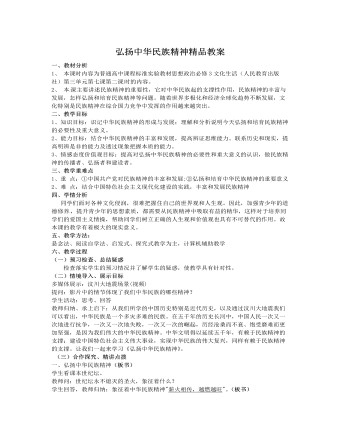
人教版高中政治必修3弘扬中华民族精神精品教案
9.我们的祖国历史悠久,文化灿烂。我国是世界著名的四大文明古国之一,有近5000年的文字记载的悠久历史,我国各民族人民创造了灿烂的古代文化和科学技术。张衡发明的“浑天仪”、“地动仪”比欧洲早1700多年;祖冲之的“圆周率”推算,比西方世界早了1000多年;华佗的全身麻醉技术也比西方早10000多年;炼铁技术的发明比欧洲早1900多年……中国的“四大发明”更是推动了人类历史文明的进程。5000多年的历史造就了中华民族灿烂的文化,涌现出大批伟大的思想家、文学家、艺术家,也出现了一大批优秀的艺术作品,这都是先人留给我们的宝贵精神财富。以上材料说明 ( )①中华文化历史悠久,源远流长是中华文化的基本特征 ②中华文化博大精深,具有非常丰富的内容 ③中华民族对人类世界的发展做出了巨大的贡献 ④中华文化曾长期居于世界文化发展的 前列,是世界上最优秀的民族文化之一A. ①② B. ①②③ C. ①②③④ D. ①②④
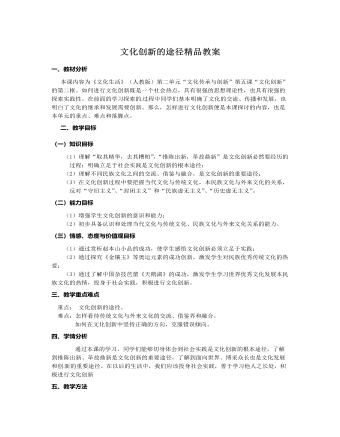
人教版高中政治必修3文化创新的途径精品教案
一、教材分析本课内容为《文化生活》(人教版)第二单元“文化传承与创新”第五课“文化创新”的第二框。如何进行文化创新既是一个社会热点,具有很强的思想理论性,也具有很强的探索实践性。在前面的学习探索的 过程中同学们基本明确了文化的交流、传播和发展,也明白了文化的继承和发展需要创新。那么,怎样进行文化创新便是本课探讨的内容,也是本单元的重点、难点和落脚点。二、教学目标(一)知识目标 (1)理解“取其精华,去其糟粕”,“推陈出新,革故鼎新”是文化创新必然要经历的过程;明确立足于社会实践是文化创新的根本途径;(2)理解不同民族文化之间的交流、借鉴与融合,是文化创新的重要途径;(3)在文化创新过程中要把握当代文化与传统文化,本民族文化与外来文化的关系,反对“守旧主义”、“封闭主义”和“民族虚无主义”、“历史虚无主义”。

人教版高中政治必修3文化在交流中传播精品教案
一、教材分析:文化在交流中传播是文化生活第二单元第三课的教学内容,主要学习文化传播的重要方式和途径,文化传播的主要方式及特点,文化多样性与文化传播的关系及化交流的相关知识。本节课内容承接第一框文化的多样性,是对第一框内容的深入。二、教学目标:1、知识目标:(1)知道文化传播的重要方式和途径;(2)列举现代文化传播的主要方式,说出它们各自的特点。2、能力目标:培养学生熟练使用大众传媒的能力。3、情感态度价值观目标:增强做中外文化交流友好使 者的责任感和使命感。三、教学重点难点:文化交流的重要性及如何加强文化交流。四、学情分析:学生对文化交流这一框的内容了解较多,对前两目的内容可以稍加点拨即可,第三目的内容可以发挥学生的积极性和主动性,通过讨论的方式深入了解,教师做好总结。五、教学方法:本课以学案导学为主,辅以案例教学法以及概念、原理教学法。
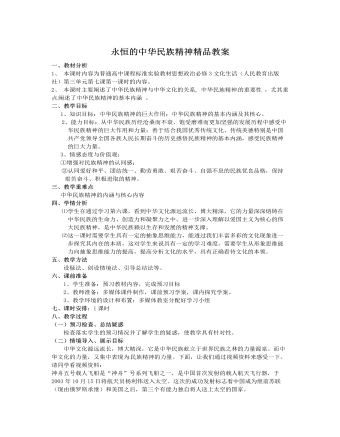
人教版高中政治必修3永恒的中华民族精神精品教案
(一)预习检查、总结疑惑检查落实学生的预习情况并了解学生的疑惑,使教学具有针对性。(二)情境导入、展示目标中华文化源远流长,博大精深,它是中华民族屹立于世界民族之林的力量源泉。而中华文化的力量,又集中表现为 民族精神的力量。下面,让我们通过视频资料来感受一下。请同学看视频资料:神舟五号载人飞船是“神舟”号系列飞船之一,是中国首次发射的载人航天飞行器,于2003年10月15日将航天员杨利伟送入太空。这次的成功发射标志着中国成为继前苏联(现由俄罗斯承继)和美国之后,第三个有能力独自将人送上太空的国家。(学生讨论)看了这段视频资料之后,同学们有什么感受?(学生发言略)(教师总结)看了这段视频资料之后,我们每个中国人都会感到热血沸腾,激动不已,一方面是因为中国很伟大,我是中国人,我感到骄傲和自豪;别一方面,也为片中主人公身上所具有的精神所折服。
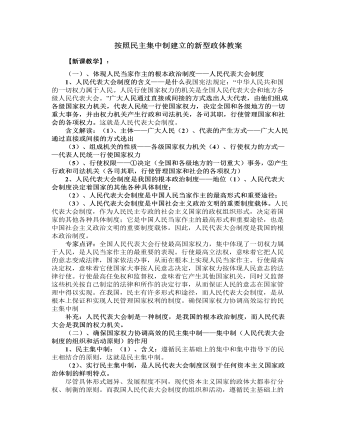
人教版高中政治选修3按照民主集中制建立的新型政体教案
◇本框题小结:◇3个体现:即人民代表大会制度是我国的根本政治制度的3个体现(1)、人民代表大会制度决定着国家的其他各种具体制度;(2)、人民代表大会制度是中国人民当家作主的最高形式和重要途径;(3)、人民代表大会制度是中国社会主义政治文明的重要制度载体。◇3个表现:即民主集中制确保国家权力协调高效的表现:(1)、从人民代表大会和人民的关系来看①各级人民代表受选民和原选举单位的监督,选民或选举单位有权罢免自己选举出的代表;②各级人民代表大会代表人民统一行使国家权力(2)、从人民代表大会与其他国家机关的关系来看①其他国家机关都由人民代表大会产生,对它负责、受它监督;②在人民代表大会统一行使国家权力的前提下,其他国家机关依照法定分工依法行使各自的职权。(3)、从中央和地方的关系来看①地方必须服从中央;②在保证中央统一领导的同时,必须考虑地方特殊利益,充分发挥地方的主动性和积极性。
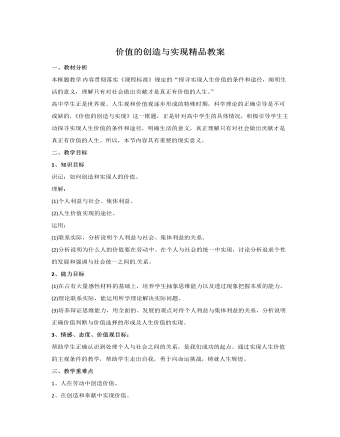
人教版高中政治必修4价值的创造与实现精品教案
2、能力目标(1)在占有大量感性材料的基础上,培养学生抽象思维能力以及透过现象把握本质的能力。(2)理论联系实际,能运用所学理论解决实际问题。(3)培养辩证思维能力,用全面的、发展的观点对待个人利益与集体利益的关系,分析说明正确价值判断与价值选择的形成及人生价值的实现。3、情感、态度、价值观目标:帮助学生正确认识到处理个人与社会之间的关系,是我们成功的起点。通过实现人生价值的主观条件的教学,帮助学生走出自我,勇于向命运挑战,铸就人生辉煌。三、教学重难点1、人在劳动中创造价值。2、在创造和奉献中实现价值。3、理解自我价值与社会价值的统一。四、学情分析高中二年级学生已经学习了哲学常识的大多数内容,基本掌握了唯物论、辩证法的科学认识问题、分析问题的方法,基本树立了正确的理想信念和价值观,了解了古今中外大量典型人物的事例,所以,应该能够比较容易地理解课本知识。
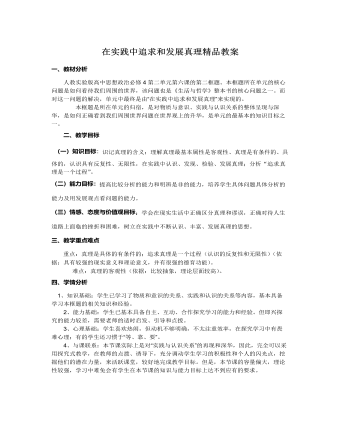
人教版高中政治必修4在实践中追求和发展真理精品教案
一、教材分析人教实验版高中思想政治必修4第二单元第六课的第二框题。本框题所在单元的核心问题是如何看待我们周围的世界,该问题也是《生活与哲学》整本书的核心问题之一。而对这一问题的解决,单元中最终是由“在实践中追求和发展真理”来实现的。 本框题是所在单元的归宿,是对物质与意识、实践与认识关系的整体呈现与深华,是如何正确看到我们周围世界问题在世界观上的升华,是单元的最基本的知识目标之一。 二、教学目标(一)知识目标:识记真理的含义;理解真理最基本属性是客观性、真理是有条件的、具体的,认识具有反复性、无限性,在实践中认识、发现、检验、发展真理;分析“追求 真理是一个过程”。(二)能力目标:提高比较分析的能力和明辨是非的能力,培养学生具体问题具体分析的能力及用发展观点看问题的能力。(三)情感、态度与价值观目标:学会在现实生活中正确区分真理和谬误,正确对待人生道路上面临的挫折和困难,树立在实践中不断认识、丰富、发展真理的思想。

新人教版高中英语必修3Unit 2 Morals and Virtues-Reading and Thinking教学设计
The topic of this part is “Learn to make choices in life”.The Listening & Speaking & Talking part aims at the moral dilemmas, and this part is about making choices in life. The heroin is Lin Qiaozhi, a famous medical scientist, made a great contribution to our country’s medical care. Most importantly, her life experience can inspire our students whether in studying or the development of career. she had moral dilemmas and life choices, which are similar to the students who will step into society. Besides, Lin has quite good virtues like kindness, self-improvement, insistence, job-loving , generosity and responsibility, which is worth being learned.Concretely, this article is a biography about Lin Qiaozhi. The article tells her whole life according the timeline, among which the life choices is emphasized. For example, whether married or chased her dream, returned home or stayed abroad, family or public, her choices all reflected her faith, spirit, responsibility and devotion.1. Fast reading to get the detailed information about Lin Qiaozhi; careful reading to do the deductive information.2. Learn the reading skills--deductive judgement according the context.3. Study the structure features and language features. 4. Communicate about Lin’s life choices and reflect their own life choices.1. Learn the reading skills--deductive judgement according the context.2. Study the structure features and language features.3. Communicate about Lin’s life choices and reflect their own life choices.Step 1 Lead in---Small talkWhat are some important life choices?Importance choices: university study, jobs and marriage partners. Because they can determine our future.

新人教版高中英语必修3Unit 3 Diverse Cultures-Discovering Useful Structure教学设计
Step 4 PracticeRead the conversation. Find out which words have been left out.Justin: Linlin, I’m going to Guizhou Province next month. I’m super excited! Any recommendations for places to visit?Linlin: Wow, cool! Guizhou is a province with a lot of cultural diversity. Places to visit...well, definitely the Huangguoshu Waterfall first.Justin: What’s special about the waterfall?Linlin: Well, have you ever heard of the Chinese novel Journey to the West ?Justin: Yes, I have. Why ?Linlin: In the back of the waterfall, you will find a cave, which is the home of the Monkey King.Justin: Really? Cool! I’ll definitely check it out.Linlin:And I strongly recommend the ethnic minority villages. You’ll find Chinese culture is much more diverse than you thought.Justin:Sounds great, thanks.Answers:Justin: Linlin, I’m going to Guizhou Province next month. I’m super excited! Do you have any recommendations for places to visit?Linlin: Wow, that’s cool! Guizhou is a province with a lot of cultural diversity. What are some places to visit in Guizhou ? Well, definitely the Huangguoshu Waterfall is the first place to visit in Guizhou Province.Justin: What’s special about the waterfall?Linlin: Well, have you ever heard of the Chinese novel Journey to the West ?Justin: Yes, I have heard of the Chinese novel Journey to the West . Why do you ask if I have heard of the Chinese novel Journey to the West?Linlin: In the back of the waterfall, you will find a cave, which is the home of the Monkey King from Journey to the West.Justin: That’s really true? It’s Cool! I’ll definitely check it out.Linlin:And I strongly recommend the ethnic minority villages on your trip to Guizhou Province. You’ll find Chinese culture is much more diverse than you thought it was.Justin:This all sounds great, thanks.

新人教版高中英语必修3Unit 3 Diverse Cultures-Reading and Thinking教学设计
Discuss these questions in groups.Q1: Have you ever been to a place that has a diverse culture ? What do you think about the culture diversity ?One culturally diverse place that I have been to is Harbin, the capital city of Heilongjiang Province. I went there last year with my family to see the Ice and Snow Festival, and I was amazed at how the culture as different to most other Chinese cities. There is a big Russian influence there, with beautiful Russian architecture and lots of interesting restaurants. I learnt that Harbin is called “the Oriental Moscow” and that many Russians settled there to help build the railway over 100 years ago.Q2: What are the benefits and challenges of cultural diversity ?The benefits: People are able to experience a wide variety of cultures, making their lives more interesting, and it can deepen the feelings for our national culture, it is also helpful for us to learn about other outstanding culture, which helps improve the ability to respect others. The challenges: People may have trouble communicating or understanding each other, and it may lead to disappearance of some civilizations and even make some people think “The western moon is rounder than his own.”Step 7 Post reading---RetellComplete the passage according to the text.Today, I arrived back in San Francisco, and it feels good (1) _____(be) back in the city again. The city succeeded in (2)_________ (rebuild) itself after the earthquake that (3)________ (occur) in 1906, and I stayed in the Mission District, enjoying some delicious noodles mixed with cultures. In the afternoon, I headed to a local museum (4)____ showed the historical changes in California. During the gold rush, many Chinese arrived, and some opened up shops and restaurants in Chinatown to earn a (5)_____ (live). Many others worked on (6)______ (farm), joined the gold rush, or went to build the railway that connected California to the east. The museum showed us (7)____ America was built by immigrants from (8)________ (difference) countries and cultures. In the evening, I went to Chinatown, and ate in a Cantonese restaurant that served food on (9)________(beauty) china plates. Tomorrow evening, I’m going to (10)__ jazz bar in the Richmond District. 答案:1. to be 2. rebuilding 3. occurred 4. that 5.living6. farms 7.how 8. different 9. beautiful 10. a

新人教版高中英语必修3Unit 4 Space Exploration-Listening&Speaking&Talking教学设计二
The themes of this part are “Talk about how to become an astronaut” and “Talk about life in space”. As Neil Armstrong said “Mystery creates wonder and wonder is the basis of man’s desire to understand. Space is difficult for human to reach, therefore, humans are full of wonders about it. However, if wanting to achieve the dream of reaching the Moon, some of our human should work hard to be an astronaut at first. Part A(Talk about how to become an astronaut) is a radio interview in a radio studio, where the host asked the Chinese astronauts about his story how to become an astronaut. Yang Liwei told his dreamed to be an astronaut since childhood. Then he worked hard to get into college at 22. The next 10 years, he gradually became an experienced pilot. At the same time, to be an astronaut, he had to study hard English, science and astronomy and trained hard to keep in good physical and mental health and to practise using space equipment. Part B (Talk about life in space) is also an interview with the astronaut Brown, who is back on the earth. The host Max asked about his space life, such as his emotion about going back the earth, the eating, shower, brushing, hobbies and his work. Part A and Part B are interviews. So expressing curiosity about the guests’ past life is a communicative skill, which students should be guided to learn.1. Students can get detailed information about how Yang Liwei became an astronaut and Max’s space life.2. Students learn to proper listening strategy to get detailed information---listening for numbers and taking notes.3. Students can learn related sentences or phrases to express their curiosity like “ I wish to know...” “I’d love to know...”4. Students can learn more about the space and astronauts, even be interested in working hard to be an astronaut

新人教版高中英语必修3Unit 5 The Value of Money-Reading for Writing教学设计二
2. 您能看到, 我头发太长了。You can see that my hair is much too long.3. 无论什么时候, 只要您想回来就回来。Please come back whenever you want.4. 您仅有很少的头发要理! You only have too little hair to cut !5. 为您服务是我的荣幸!It is my honour to serve you!Step 9 Writing(Henry is walking down the street when he sees a sign for a place that cuts hair. He decides to have it cut. )H=Henry B=BarberH: Good afternoon, I’d like to have my hair cut, if I may. (The barber looks at Henry’s hair and continues cutting another man’s hair. ) Er, I’d really like a haircut. As you can see it’s much too long. B: (in a rude manner) Yes, I can see that. Indeed, I can. H: Fine, well, I’ll have a seat then. (He sits in one of the barber’s chairs. The barber turns to look at Henry. )B: It’s quite expensive here, you know! Are you sure you can afford it?H: Yes. I think so. (After his hair is cut, the barber tells Henry how much he must pay. Henry shows the barber the bank note. )B: Why Mr. . . (looks shocked)H: Adams. Henry Adams. I’m sorry. I don’t have any change. B: Please don’t worry! (wearing a big smile) Nothing to worry about! Nothing at all! Please come back whenever you want, even if you only have too little hair to cut! It will be my honour to serve you!Step 10 Pair workExchange drafts with a partner. Use this checklist to help your partner revise his/her draft.1. Are all the elements of a play included and in good order ?2. Do the character use suitable language ?3. Are the stage directions clear and useful ?4. Is the plot clear and exciting enough ?

新人教版高中英语选修2Unit 1 Science and Scientists-Reading and thinking教学设计
Step 5: After learning the text, discuss with your peers about the following questions:1.John Snow believed Idea 2 was right. How did he finally prove it?2. Do you think John Snow would have solved this problem without the map?3. Cholera is a 19th century disease. What disease do you think is similar to cholera today?SARS and Covid-19 because they are both deadly and fatally infectious, have an unknown cause and need serious public health care to solve them urgently.keys:1. John Snow finally proved his idea because he found an outbreak that was clearly related to cholera, collected information and was able to tie cases outside the area to the polluted water.2. No. The map helped John Snow organize his ideas. He was able to identify those households that had had many deaths and check their water-drinking habits. He identified those houses that had had no deaths and surveyed their drinking habits. The evidence clearly pointed to the polluted water being the cause.3. SARS and Covid-19 because they are both deadly and fatally infectious, have an unknown cause and need serious public health care to solve them urgently.Step 6: Consolidate what you have learned by filling in the blanks:John Snow was a well-known _1___ in London in the _2__ century. He wanted to find the _3_____ of cholera in order to help people ___4_____ it. In 1854 when a cholera __5__ London, he began to gather information. He ___6__ on a map ___7___ all the dead people had lived and he found that many people who had ___8____ (drink) the dirty water from the __9____ died. So he decided that the polluted water ___10____ cholera. He suggested that the ___11__ of all water supplies should be _12______ and new methods of dealing with ____13___ water be found. Finally, “King Cholera” was __14_____.Keys: 1. doctor 2. 19th 3.cause 4.infected with 5.hit 6.marked 7.where 8.drunk 9.pump 10.carried 11.source 12.examined 13.polluted 14.defeatedHomework: Retell the text after class and preview its language points

新人教版高中英语选修2Unit 3 Food and Culture-Discovering useful structures教学设计
The newspaper reported more than 100 people had been killed in the thunderstorm.报纸报道说有一百多人在暴风雨中丧生。(2)before、when、by the time、until、after、once等引导的时间状语从句的谓语是一般过去时,以及by、before后面接过去的时间时,主句动作发生在从句的动作或过去的时间之前且表示被动时,要用过去完成时的被动语态。By the time my brother was 10, he had been sent to Italy.我弟弟10岁前就已经被送到意大利了。Tons of rice had been produced by the end of last month. 到上月底已生产了好几吨大米。(3) It was the first/second/last ... time that ...句中that引导的定语从句中,主语与谓语构成被动关系时,要用过去完成时的被动语态。It was the first time that I had seen the night fact to face in one and a half years. 这是我一年半以来第一次亲眼目睹夜晚的景色。(4)在虚拟语气中,条件句表示与过去事实相反,且主语与谓语构成被动关系时,要用过去完成时的被动语态。If I had been instructed by him earlier, I would have finished the task.如果我早一点得到他的指示,我早就完成这项任务了。If I had hurried, I wouldn't have missed the train.如果我快点的话,我就不会误了火车。If you had been at the party, you would have met him. 如果你去了晚会,你就会见到他的。
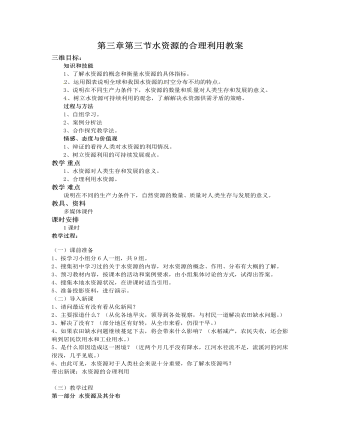
人教版高中地理必修1第三章第三节水资源的合理利用教案
5、请列举开源的措施。(包括合理开发和提取地下水;修筑水库;开渠引水实行跨流域调水;海水淡化;人工增雨等。6、开源“五水”歌:开发地下水、蓄积洪水,跨流域调水,淡水海水,人增雨水。能马上背出来吗?7、请列举节流的措施。(包括加强宣传教育,提高公民节水意识;重视改进农业灌溉技术,提高工业用水的重复利用率等。)8、水资源时刻影响着我们的生存和发展,尽管我们已经学习了关于如何合理利用水资源的知识,但关键还是要研究问题和解决问题,面对复杂的生活环境,具体问题要具体分析,看课本70页“活动”,请小组派代表回答问题。提示:(1)西北地区的水资源供给,从可持续发展的角度,解决水资源的供求矛盾应体现在:控制人口数量,减少用水规模;发展节水农业;保护生态环境,退耕还林还草。(2)我国缺水问题,谈谈看法:通过电视、报纸杂志、互联网收集有关水资源的资料;确定综合思维、立体思维的方法,全面多角度地寻找解决缺水的对策。
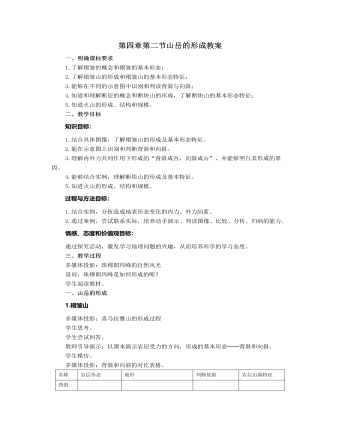
人教版高中地理必修1第四章第二节山岳的形成教案
一、明确课标要求1.了解褶皱的概念和褶皱的基本形态;2.了解褶皱山的形成和褶皱山的基本形态特征;3.能够在不同的示意图中识别和判读背斜与向斜;4.知道和理解断层的概念和断块山的形成,了解断块山的基本形态特征;5.知道火山的形成、结构和规模。二、教学目标知识目标:1.结合具体图像,了解褶皱山的形成及基本形态特征。2.能在示意图上识别和判断背斜和向斜。3.理解内外力共同作用下形成的“背斜成谷,向斜成山”,并能够明白其形成的原因。4.能够结合实例,理解断块山的形成及基本特征。5.知道火山的形成、结构和规模。过程与方法目标:1.结合实例,分析造成地表形态变化的内力、外力因素。2.通过案例,尝试联系实际,培养动手演示、判读图像、比较、分析、归纳的能力。

